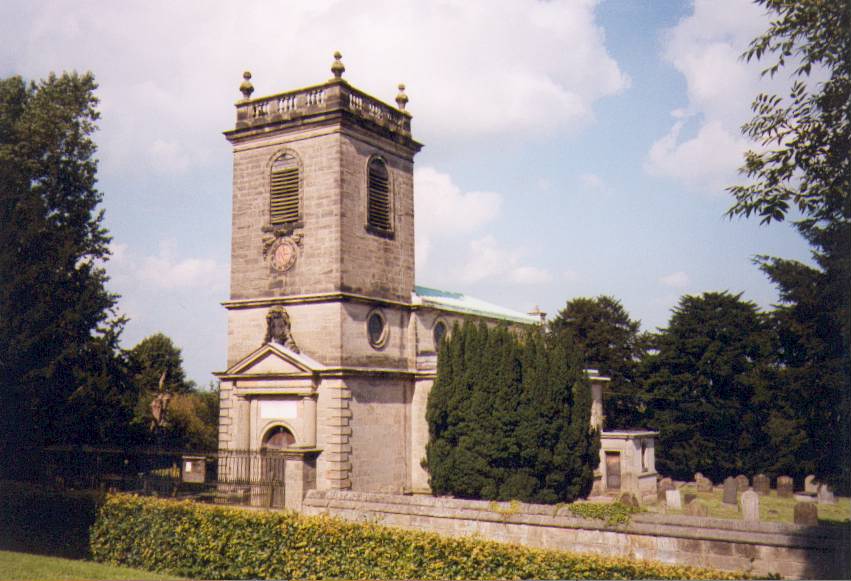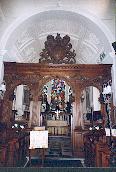
The Rector is
the Rev.Adrian Stone Tel:
01785 253493
Curate:
Becky richards Tel: 01785 747969
Churchwardens
are: Mrs Sue Haenelt Tel:07764452882
Mr Anthony Young Tel: 01889 270368
Services
are normally held on the 2nd and 4th Sundays in the
month at
11.15am using the Book of Common Prayer
services.
Matins on the 2nd Sunday and Holy Communion on the 4th
Sunday. See Church News.
St
Mary's
Church at Ingestre is part of the Lichfield
Diocese
and
the United
Benefice with
St John's, Littleworth and St John's, Tixall.
EARLY HISTORY:-
There are
references
to a chaplain at Ingestre in 1305, and to the advowson
of Ingestre
Church in 1307. Originally it was a Chapel of Ease,
established by the
Lord of the Manor with the Bishop's consent, as
Ingestre was too far
from
St Mary's, Stafford for people to walk there regularly
for services.
In the late 15th
century,
between 1485 and 1509, William Chetwynd built a
chapel on the waste of
Ingestre dedicated to St Erasmus, a Bishop &
Martyr from about
300AD. The chapel was endowed with lands to maintain
a priest, and soon
became
famous for its adjoining, medicinal salt springs. It
was visited by the
lame and diseased, with the walls hung about with
crutches. In
1536
it was valued at £10 - 16s - 8d, compared with
Tixall nearby
valued
at £8 - 7s - 4d.
The exact
site of
this earlier Chapel is not known, but some of the
stained glass was
reused in the present Church, after the Chapel had
been taken down in
the 1670s.
PRESENT CHURCH:-
The Church of St Mary,
Ingestre is
a Grade I Listed Building, finished in 1676, and
reputed to be to a
design by Christopher Wren. The foundations were laid
in 1673: "
mill'd shillings, halfpence and farthings, coyn'd that
year, being put
into hollow places cut fit for that purpose in the
large corner stones
of the steeple, by Mr Chetwynd himself and other
gentlemen."
The Church was
consecrated in
August 1677 with the Bishop baptizing a child,
churching a woman,
joining a couple in matrimony and burying another,
all on the same day
- no wonder it had taken some time after the
completion of the building
in 1676 to arrange all these together. The idea was
to emphasize that
this was a Parish Church, and not a private Chapel
for the Chetwynd
family.
The exterior is
all
ashlar faced
and the west door has Tuscan columns and a pediment
leading from the
tower
into the church. There is a plaque recording the
dedication of the
Church
by Walter Chetwynd in 1676 and the Chetwynd Coat of
Arms. The exterior
of
the tower is decorated with garlands, a balustrade
and urns. Inside the
floor
is black and white marble and there is a very fine
stucco ceiling. The
nave
has four arcaded bays with Doric Columns on tall
square bases.

The pews,
originally box
pews, are of Flanders Oak. There is a handsome
screen decorated with
the Royal Coat of Arms, and a richly carved pulpit
with tester by
Grinling Gibbons, signed with his open pea
pods.
Lighting was
installed in 1886, 4 years after the fire at
Ingestre Hall.
 There
are some
excellent late17th century and 19th century mural
tablets and other
monuments recording members of the Chetwynd family,
including a fine
1918 monument to Viscount Ingestre by Countess
Feodora Gleichen
There
are some
excellent late17th century and 19th century mural
tablets and other
monuments recording members of the Chetwynd family,
including a fine
1918 monument to Viscount Ingestre by Countess
Feodora Gleichen

The font is marble with a
contemporary
cover.
All graves and
monuments
have been recorded by the Local History Group, and
these records
alongwith all burial records for Ingestre have been
entered on a
database. Searches by name can be carried out for a
small donation to
cover expenses and towards the upkeep of Ingestre
Church. Contact Anne
Andrews Tel: 01785 246101 or Tixandrews@hotmail.com
for further details.
Ingestre
Church Website